Other Africa Lines
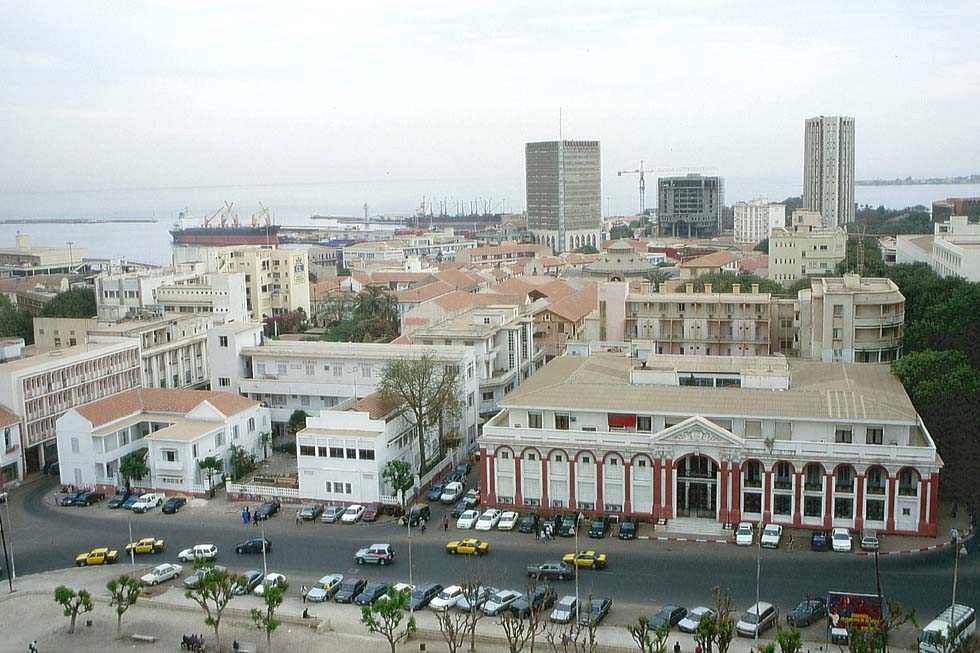
Dakar (WS)
France
In the 17th century, under Louis XIV, France established its West African colony Senegambia. At the outbreak of WWI, Morocco and the Maghreb vast parts of West and Central Africa, Djibouti and the islands of Magadascar and Reunion in the Indian Ocean were in French possession.
The Compagnie de Navigation Mixte, founded in 1856 by Arnaud and Touache, was a pioneer by sending the auxiliary vessel "Europe" from Marseilles to the Far East via the Cape. The first true steamer to undertake this voyage in 1826 was the "Imperatrice" of the Cie. des Services Maritimes, but the mail route was installed by the way of Egypt. The Compagnie de Navigation Paquet, created in 1863, became the traditional provider of North Africa services from Marseilles. The Compagnie Maritime des Chargeurs Reunis, founded in 1871 for passenger-cargo services, got in 1889 a subsidized mail contract for a route from Le Havre to Dakar, Senegal. A similar contract for Marseilles - Dakar was awarded to Fraissinet. Cook's timetable listed at the end of the 19th century the Fraissinet S.S.Co. with the service Marseilles - Dakar - Libreville - Loango and Chargeurs Reunis with a route Le Havre - Dakar - Libreville - Cotonou.
Brazzaville, the capital of French Equatorial Africa (until 1919 French Congo), was connected with its harbour Pointe Noire in 1934, when the railway Chemin de fer Congo-Ocean was completed. At that time the "Explorateur Grandidier" (1925/10,268 gt) of Messageries Maritimes was the largest French ship on West Africa services.
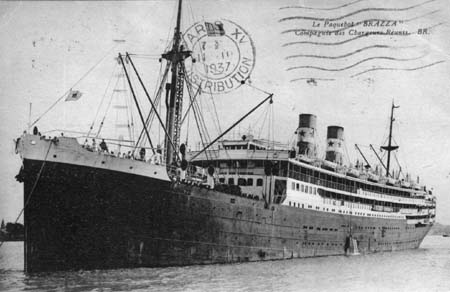
"Brazza", Chargeurs Reunis (old card, coll. WS)
|
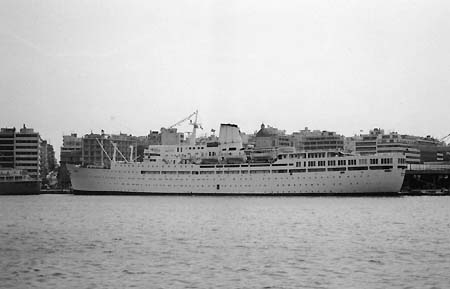
"Mermoz" ex "Jean Mermoz", Nouvelle Cie. De Paquebots, ex Fraissinet, Piraeus 1977 (WS)
|
After World War II the Cie de Navigation Fraissinet et Cyprien Fabre and the Nouvelle Compagnie de Paquebots provided services to Pointe Noire. The latter company maintained Dakar, Pointe Noire and Lome services still in the '60s with the "General Mangin" (1953/12,457 gt) and sister "Jean Mermoz" (built in 1957 for Fraissinet / Fabre) as well as the "Foucould" (1948/9,505 gt) and consorts, nice motorships with a black funnel. In 1969 the French Congo services ended. The Compagnie de Navigation Paquet had introduced in 1962 the white 14,224-ton motor-ship "Ancerville" with 2 parallel funnels on the Marseilles - Dakar route, in 1970 given away to the Nouvelle Compagnie de Paquebots and in 1973 sold to China, becoming the "Ming Hua" on Tanzania services and then a hotel ship. At the end of the '70s the Shipping Guide listed only a regular service Marseilles - Casablanca - Dakar by Paquet Cruises with the 10,513-ton car ferry "Massalia", which had been introduced in 1971 by the Nouvelle Compagnie de Paquebots on Canaries services. She was sold in 1983 to Stena Line, renamed "Stena Baltica", then "Island Fiesta" and "Scandinavian Star" for cruises, suffered a fire in the Gulf of Mexico, was chartered by Da-No of Denmark, caught fire once again, arson being considered the cause, became the "Regal Voyager" and was scrapped at Alang in 2004.
Germany
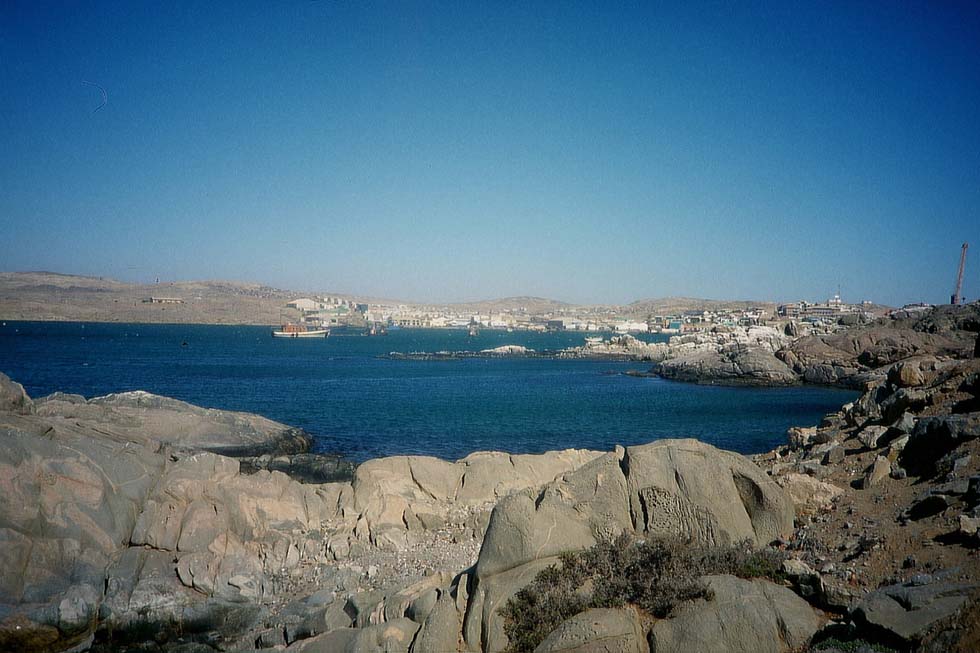
Luderitz, Namibia (WS)
Under Wilhelm I, Germany became the newcomer among the colonial powers, proclaiming in 1884 Togo, Cameroon, Deutsch Suedwest-Afrika (now Namibia) and in 1885 Deutsch Ost-Afrika (now Tanzania) as "Protected Territories", which meant nothing else than colonies. Rivalling the French dominance over Morocco, Wilhelm II visited in 1905 the Sultan of Morocco, arriving seasick in Tangiers. In 1911 he sent the gunboat "Panther" to Agadir, provoking almost an all-out war.
The German entrepreneur Carl Woermann was engaged in the West African trade from 1854. His son Adolph Woermann founded in 1882 C.Woermann's Deutsche Dampfschiffahrt. Under mail contract he opened services Hamburg - Cameroon for cargo and a few passengers. From 1885 the re-organized company was known as Woermann-Linie. He extended the services to Nigeria, Angola, serving from 1890 Morocco and from 1891 Deutsch Suedwest-Africa (Namibia), where the port-of-call changed soon from British-administrated Walvis Bay to nearby Swakopmund. In the south, the businessman Adolf Luederitz had acquired the bay then named after him. From 1888 it was regularly connected with Cape Town by sailing-vessels until Premier-Lieutenant Troost arranged a steamer service Swakopmund - Cape Town. Adolph Woermann dreamt of a route extension to Deutsch Ost-Afrika (Tanzania) via the Cape, but the German parliament refused. Nevertheless operating successfully, the company took over vessels from the Hamburg-Sued and commissioned new ones. The largest were the "Eleonore Woermann" (1902/4,624 gt) and sister "Lucie Woermann", ships with a grey hull, white superstructure and a single black funnel with white/green/blue rings.
In order to serve East Africa via the Suez Canal, the German government supported in 1890 creation of the Deutsche Ost-Afrika-Linie (DOAL) , under management of Woermann (see also chapter Branch Lines / Africa). In 1894 the company added a route from Hamburg to Durban in South Africa via the Cape and commissioned for this service the "Herzog" (1896/4,933 gt) and the "Koenig". When in 1895 the Jameson Raid of the British against the Boers had failed, the German emperor Wilhelm II congratulated the Boers' president Krueger - and infuriated England. The Woermann family acted wiser: DOAL introduced instead the new steamers on the route Hamburg - Suez - Dar es Salaam and from 1898 also Durban was connected via Suez, no longer via Cape Town, in order to avoid a clash with the British. Only from 1901, when the Boer War was no longer a political obstacle, a new 'Rund-um-Afrika' (round Africa) route was operated by DOAL on the circuit Hamburg - Bremerhaven - Cape Town - Suez - Hamburg and in reverse direction. For this main line the "Kronprinz" (1900/5,645 gt) and consorts were introduced, steamers with a grey hull, white superstructure and a buff funnel, topped with an arrangement of black/white/red rings, pointing the national colours.
In Deutsch Suedwest-Afrika occurred one of the greatest tragedies in colonal history, when in 1904 the native Hereros arose against the German administration which had the cattle-breeding people expelled from the pastures. In the course of the military expedition of the Germans, the Herero population was decimated from 80,000 to about 12,000 until the end of the rebellion in 1907. The military logistics had been in the hands of Woermann, NDL and Hapag, resulting in a jointly operated fast line Hamburg - Duala, Cameroon, from 1911.
World War I hit German shipping hard and the Woermann family gave their shares away to Hapag and NDL. In 1928 the 9,552-ton "Watussi" and "Ubena" were introduced as the first two-funnel turbine steamers of the company sporting the DOAL label, employed on the 'Rund-um-Afrika' route. In 1934 the government took over the shares and in 1936 two larger turbine steamers were launched, the "Pretoria" and the "Windhuk" of 16,662 tons each. And there were passenger-cargo services, e.g. to Cameroon by Reederei F. Laeisz, famous for their tradition with sailing ships.
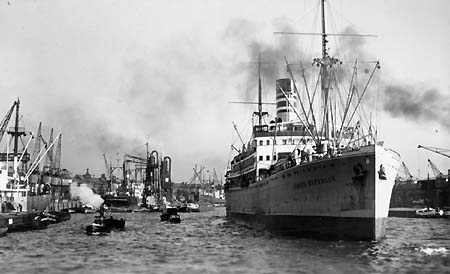
"Adolph Woermann", Woermann-Linie (old card)
|
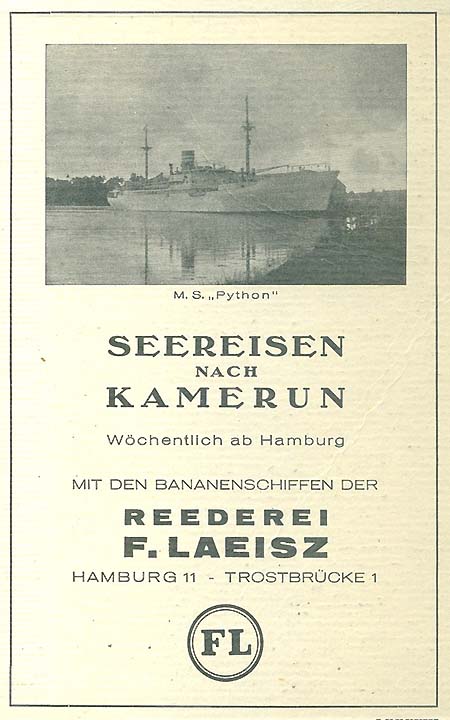
"Python", Laeisz (advertisement 1939)
|
With WWII German passenger shipping to Africa ended for ever. While the "Windhuk" went to the scrapyard in 1966 after having served as a U.S. troop transporter, the "Pretoria" had a complicated career: In 1945 she became the "Empire Doon" of the British Ministry of Transport, then "Empire Orwell", in 1958 chartered by Pan Islamic of Karachi, thereafter acquired by the Blue Funnel Line, in 1959 renamed "Guning Djati" and finally in 1964 taken over by Pelajaran Sang Saka of Jakarta. She was scrapped in 1987.
Portugal
On account of their rivalry, the great powers did not object to the Portuguese territories of Angola and Mozambique. In the 19th century a short-lived service of the Mala Real reached Portuguese East Africa (now Mozambique), but in 1892 the company went into liquidation and the government awarded the mail contract to the Union Line of the British. Towards the end of the 19th century Cook's timetable listed services from Lisbon to Luanda and Mossamedes in Angola by the Portuguese National Navigation Co. East Africa should have been connected by a Portuguese "Atravez Africa" railway from Luanda to Beira on the Indian Ocean. Not being in British interest, it remained a dream. In 1929 however the Benguela Railway, financed by Sir Robert Williams, once the companion of the late Cecil Rhodes, was completed from the Angolan port of Lobito inland. It provided an access to the Belgian Congo and it was praised as the fastest connection from Europe to Cape Town by steamer and train. The shipping company serving the ports of Angola became known under its Portuguese name Empreza nacional de Navegacao. But also the Union-Castle Line connected the ports of Angola.
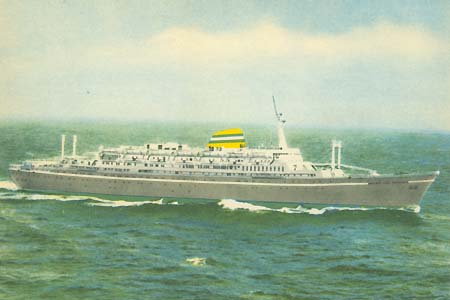
"Infante Dom Henrique", Cia. Colonial de Navegacao (old card, coll. WS)
|
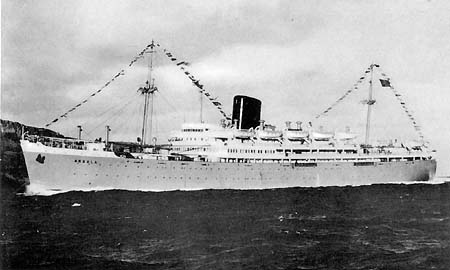
"Angola", Cia. Nacional de Navegacao (old card, coll. WS)
|
Still in 1960 the Companhia Colonial de Navegacao advertised Angola and Mozambique services, depicting the 19,200-ton "Patria". A brutal war, caused by the East-West conflict, was fought in Angola and historian Curt Frick listed in the '60s the steamer "Vera Cruz" (1952/21,765 gt) employed on Angola services, including troop transports. The smaller M.S. "Uige" (1954/10,000 gt) served Angola and Sao Tome island, the Portuguese colony on the West Coast. The steamer "Infante Dom Henrique" (1961/23,306 gt) was employed on a route Lisbon - Luanda - Cape Town - Lourenco Marques, Mozambique. The Companhia Nacional de Navegacao was listed with the modern steamer "Principe Perfeito" (1961/19,309 gt) on a route from Lisbon via Luanda to Beira and with passenger-cargo vessels. In 1974 the Companhia Portuguesa de Transportes Maritimos was created by a merger (including the island services Carregadores Acoreanos and Empresa Insulana), serving Angola, Mozambique and the North Atlantic route. Towards the end of the '70s all these Portuguese services had disappeared form the timetable. Among the above-mentioned ships the "Infante Dom Henrique" had the longest career - see chapter Pullmantur Cruises.
Belgium & Congo
The discoveries in the Congo region were made in the 1870s by John Rowlands, known under the name Sir Henry Morton Stanley, financed by William Mackinnon of the British India Line. In 1885 the rivaling colonial powers conceded the Congo to King Leopold II of neutral Belgium to his private usage as "Etat Independent du Congo". The Societe Gantoise de Navigation was the first company to introduce in 1886 an ocean steamer service from Belgium to Boma in the mouth of the Congo River. In 1889 an ocean steamer of the African Steamship Co. entered the Congo further upstream to Matadi. As the river Congo is navigable only beyond Kinshasa (at that time Leopoldville), a railway Matadi - Leopoldville had to be built, completed in 1898. Leopold II was willing to grant subsidies for a mail steamer connection with Belgium. For that purpose the Cie. Maritime Belge du Congo was founded by the African Steamship Co., which had become a subsidiary of the Elder Dempster Group, and the Societe Maritime du Congo by Adolph Woermann. The Compagnie Maritime Belge du Congo opened the service Antwerp - Matadi in 1895 with the "Leopold" (I), joined by three other steamers. The Societe Maritime du Congo introduced the "Eduard Bohlen" of the Woermann-Linie on the Matadi route and commissioned the "Bruxellesville". As this contingent proved uneconomic, Woermann withdrew from the service in 1901. Upon the regardless exploitation of the Congo, 11 of the 20 million inhabitants lost their life within two decades. That disaster caused the great powers to force Leopold II to establish in 1908 the official colony Congo Belge.
After World War I, in 1919, the Lloyd Royal Belge decided to start a Belgium - South Africa service and commissioned 4 two-funnel 10,000-ton ships. Additionally, the laid-up 9,735-ton "Indara" (built in 1912 for the Australian S.N.Co.) was acquired, reportedly by for a new River Plate route. Renamed "Pays de Waes", the ship, the largest among the 92 LRB vessels (according to Dunn), opened the Africa service in 1920, with Prince Leopold among the passengers. Soon the LRB abandoned the project, the orders were cancelled and the "Pays de Waes" became the "Horai Maru" of the Osaka Shosen Kaisha. The competing British-founded company, continuing to serve Matadi, and the Lloyd Royal merged in 1930 into the truly Belgian Compagnie Belge Maritime du Congo. Their largest ships were the "Albertville" (1928/10,338 gt) and the "Leopoldville" (1929/11,172 gt), both built for a moderate speed of 15 knots.
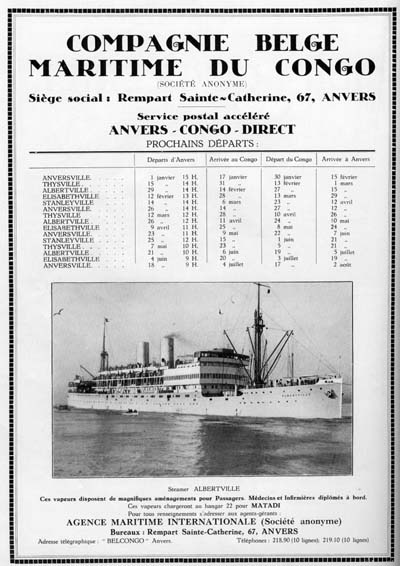
"Albertville", timetable and connections (via Wikimedia)
|
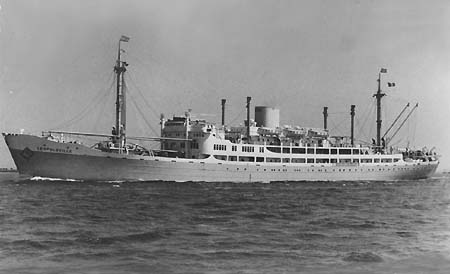
"Leopoldville", Antwerp (old card, coll. WS)
|
In 1960 Belgium released the Congo into independence, completely unprepared. Foundation of the Republique du Zaire in 1971 could not stop the troubles. In the 60s, services Antwerp - Lobito - Matadi by the CMB were listed with the motor-ships "Albertville" "Elisabethville", "Leopoldville" (1948/10,877 gt each) and "Charlesville" (1951/10,946 gt). Still at the end of the 70s the ABC Shipping Guide pointed out services Antwerp - Lisbon - Tenerife - Abidjan - Matadi by the Compagnie Maritime Belge (CMB N.V.) and Compagnie Maritime Zairoise with the "Fabiolaville" and the "Kananga", cargo motorships of 13,841 tons with cabins for 71 passengers. The "Fabiolaville" of CMB was sold in 1989 to China as "Hai Hua". The "Kananga" of Zaire arrived in 1996 as "Bella Vista" at Alang scrapyard.
Netherlands
Still in our days many inhabitants of the Cape region speak Afrikaans, a Dutch language. The mail steamers to Nederlandsch Indie of course took the Suez Canal on the way to the Indian Ocean, but during World War I temporarily the route round the Cape was used. Shortly after, in 1919, the Hollandsche Zuid-Afrikaansche S.M. was founded to introduce South Africa services with passenger-cargo vessels. In 1932 the Vereenigde Nederlandsche Scheepvaart Maatschappij took over the company and renamed its round-Africa service Holland-Afrika Lijn. Still in the 1960s the motor-ships "Randfontein" (1958/13,694 gt), "Jagersfontein" and sister "Oranjefontein" (1950/10,579 gt) with their black/red funnel were employed on regular Amsterdam - Cape Town - Lourenco Marques services. The Koninklijke Java - China - Paketvaart Lijnen N.V. operated a Far East - South Africa service. Curt Frick listed the black/white M.S. "Boissevain" (14,285 gt), "Ruys", "Tegelberg" of 1937/38 and the smaller "Tjitjalenka" on a route from Yokohama via Singapore and Cape Town to Rio de Janeiro and Buenos Aires even decades after WWII.
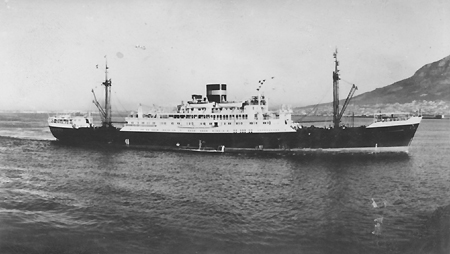
"Klipfontein", Holland-Afrika Lijn (old card, coll. WS)
|
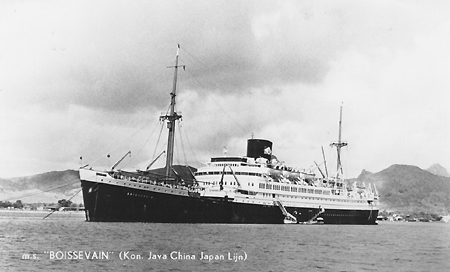
"Boissevain", Kon. Java China Japan Lijn (old card, coll. WS)
|
Italy
The government of South Africa concluded in 1933 a subsidized mail contract with the 'Italia' Flotte Riunite. As a result, that Italian government-dependent company transferred the "Duilio" and "Giulio Cesare" to a Genoa - Cape Town - Durban route. With a tonnage of more than 23,000 and a speed of 19 knots they competed with the Union Castle liners. In 1937 both ships went into the ownership of the Lloyd Triestino with the intention to be used for Far East destinations. Before WWII also the 23,961-ton "Conte Grande" was listed with South Africa services. In 1942 the "Giulio Cesare" was chartered by the International Red Cross for repatriation of Italian citizens from East Africa. With Italy's change of fronts in 1943, both ships became German booty and as such they were sunk by Allied air attacks on Trieste in 1944. After WWII, Flotta Lauro and Lloyd Triestino served temporarily African destinations. Still in the 1960s Lloyd Triestino was listed with the nice motor-ships "Africa" and "Europa" (11,440 gt) of 1952 on a Cape Town route, via the East Coast however.
Other Flags
The United States did not intervene in the struggle for African colonies. The American South African Line/Farrell Lines offered services New York - Cape Town - Beira before WWII. Still in the 1970s appeared passenger-cargo services from New York to Mombasa in the timetable. And the most renowned one, the Union-Castle Line, ran freighters rebuilt with passenger accommodation from Cape Town to the USA after WWII.
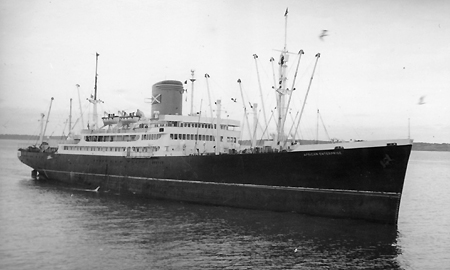 "African Enterprise", Farrell Lines (old card, coll. WS)
"African Enterprise", Farrell Lines (old card, coll. WS)
Spain was a minor colonial power in Africa, owning Spanish-Morocco, West Sahara and Spanish Guinea with the island of Fernando Poo. Cook's timetable listed at the end of the 19th century a service of the Compania Trasatlantica from Liverpool to Mogador in West Morocco. After WWII it was the Compania Trasmediterranea which maintained still in the '60s a service from Barcelona to Monrovia, the capital of Liberia, and Santa Isabel on Fernando Poo island with several passenger-cargo motor ships, the oldest being the 6,914-ton "Domine" of 1935. After the ocean liners already had disappeared, the ABC Shipping Guide listed still at the end of the '70s an irregular service from Bilbao to Equatorial Guinea.
At the same time Karageorgis Lines of Greece operated an occasional itinerary Southampton - St. Helena - Cape Town - Durban with the beautiful "Navarino" (22,725 gt), the former "Gripsholm" of Svenska Amerika Linjen. The liners gave way to cruises - scarcely however to be seen on the lonely seas around the Cape of Good Hope.
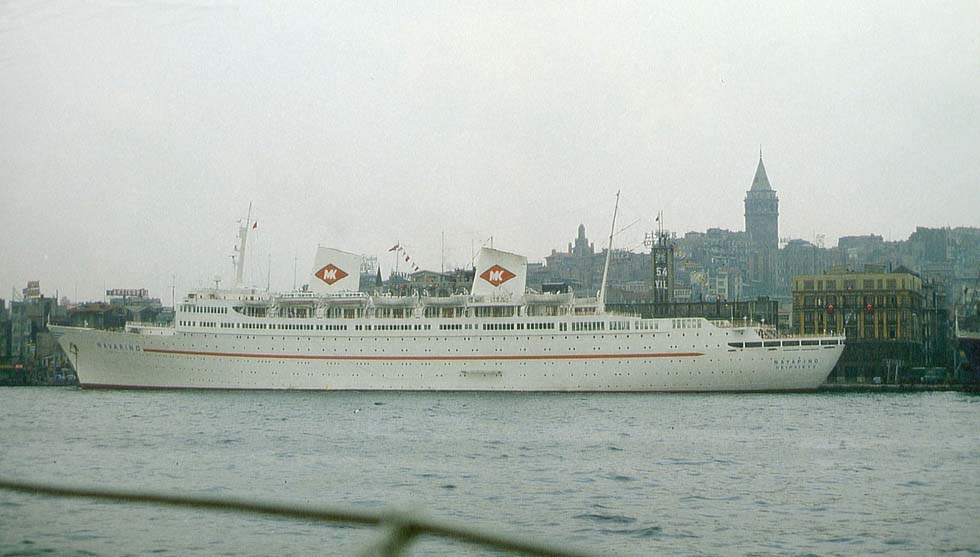
"Navarino" of Karageorgis Lines, ex "Gripsholm", Istanbul 1977 (WS)
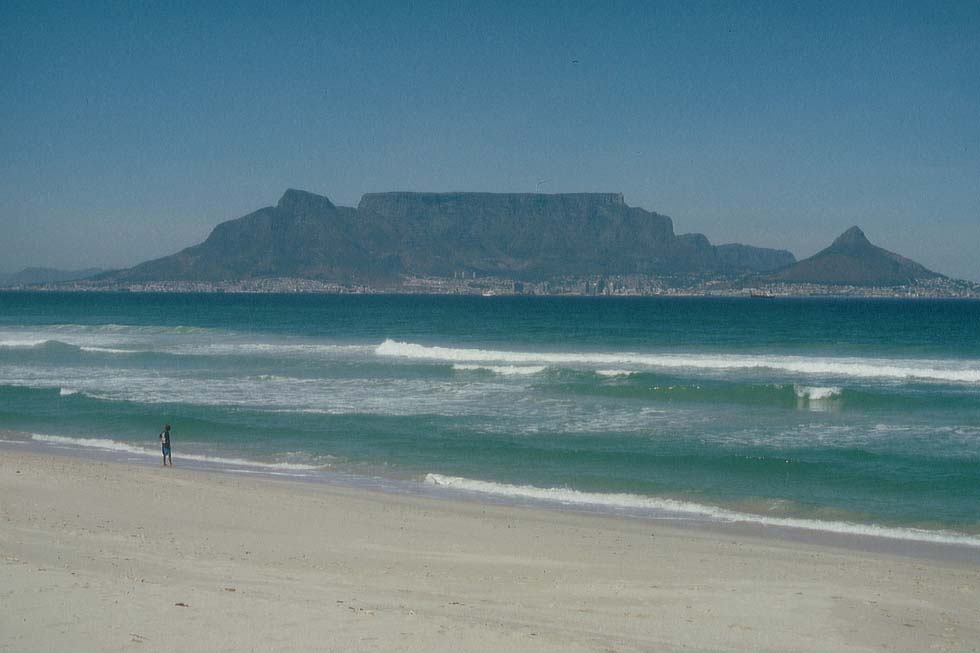
Cape Town, Table Mountain (WS)
|